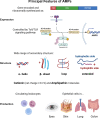Lung antimicrobial proteins and peptides: from host defense to therapeutic strategies
- PMID: 39052018
- PMCID: PMC11495187
- DOI: 10.1152/physrev.00039.2023
Lung antimicrobial proteins and peptides: from host defense to therapeutic strategies
Abstract
Representing severe morbidity and mortality globally, respiratory infections associated with chronic respiratory diseases, including complicated pneumonia, asthma, interstitial lung disease, and chronic obstructive pulmonary disease, are a major public health concern. Lung health and the prevention of pulmonary disease rely on the mechanisms of airway surface fluid secretion, mucociliary clearance, and adequate immune response to eradicate inhaled pathogens and particulate matter from the environment. The antimicrobial proteins and peptides contribute to maintaining an antimicrobial milieu in human lungs to eliminate pathogens and prevent them from causing pulmonary diseases. The predominant antimicrobial molecules of the lung environment include human α- and β-defensins and cathelicidins, among numerous other host defense molecules with antimicrobial and antibiofilm activity such as PLUNC (palate, lung, and nasal epithelium clone) family proteins, elafin, collectins, lactoferrin, lysozymes, mucins, secretory leukocyte proteinase inhibitor, surfactant proteins SP-A and SP-D, and RNases. It has been demonstrated that changes in antimicrobial molecule expression levels are associated with regulating inflammation, potentiating exacerbations, pathological changes, and modifications in chronic lung disease severity. Antimicrobial molecules also display roles in both anticancer and tumorigenic effects. Lung antimicrobial proteins and peptides are promising alternative therapeutics for treating and preventing multidrug-resistant bacterial infections and anticancer therapies.
Keywords: antibiotic resistance; antimicrobial peptide (AMP); antimicrobial proteins and peptides (AMPPs); immunomodulation; lung cancer; pneumonia.
Conflict of interest statement
No conflicts of interest, financial or otherwise, are declared by the authors.
Figures











References
-
- Xu J, Murphy SL, Kochanek KD, Arias E. Mortality in the United States, 2021. NCHS Data Brief 456: 1–8, 2022. - PubMed
Publication types
MeSH terms
Substances
Grants and funding
LinkOut - more resources
Full Text Sources

